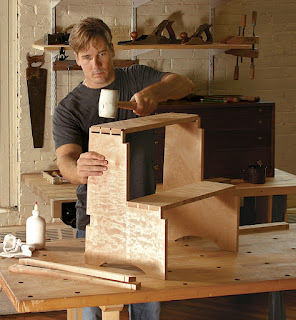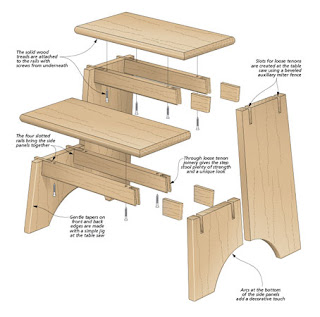Hutch Furniture Plans for Elegant Storage Solutions
The hutch, a venerable piece of furniture with roots stretching back centuries, offers a sophisticated blend of functionality and aesthetic appeal. Far from being a mere storage unit, a well-designed hutch can serve as a focal point in a room, enhancing its ambiance while discreetly concealing clutter. This comprehensive guide explores diverse hutch furniture plans, detailing design considerations, material choices, and construction techniques to help you craft elegant storage solutions for your home.
Understanding the Versatility of Hutches
The enduring popularity of hutches stems from their remarkable versatility. They seamlessly integrate into various settings, from traditional dining rooms to modern living spaces and even home offices. Their adaptable nature allows for customization, making them ideal for personalized storage solutions. A hutch's functionality extends beyond simple storage; it can also serve as a display cabinet for cherished collectibles, a buffet for serving food, or a dedicated workspace with integrated shelving.
Types of Hutches: A Design Overview
Numerous hutch styles cater to diverse tastes and interior design preferences. Understanding these variations is crucial in selecting the appropriate plan for your needs.
- Traditional Hutches: These often feature ornate carvings, detailed molding, and a classic silhouette. Materials like solid wood (cherry, mahogany, oak) are common.
- Modern Hutches: Characterized by clean lines, minimalist designs, and often incorporating glass and metal accents. Materials may include lacquered wood, tempered glass, or stainless steel.
- Mission-Style Hutches: These embody simplicity and functionality, with sturdy construction and a focus on natural wood grains. The design emphasizes clean lines and minimal ornamentation.
- Country Hutches: These often incorporate distressed finishes, rustic hardware, and a homey feel. Materials like pine or reclaimed wood are frequently used.
- Built-in Hutches: Designed to seamlessly integrate into existing cabinetry or wall units, maximizing space efficiency. These require careful planning and often involve custom construction.
Planning Your Hutch Project: Dimensions and Functionality
Before embarking on the construction process, meticulous planning is paramount. This involves determining the desired dimensions, considering the available space, and defining the intended functionality of your hutch. Accurate measurements are essential to ensure a perfect fit and prevent costly mistakes.
Determining Dimensions and Space Requirements
The dimensions of your hutch should be carefully considered in relation to the available space and the intended purpose. Consider the following factors:
- Height: Will the hutch reach the ceiling, or will it sit on a counter or table? The height significantly impacts the overall visual impact.
- Width: The width should be proportional to the available wall space and the surrounding furniture.
- Depth: A deeper hutch provides more storage, but excessive depth can overwhelm a smaller room. Consider the practicality of accessing items stored at the back.
Defining Functionality and Storage Needs
The intended use of the hutch dictates the internal configuration. Determine what you intend to store – dishes, books, collectibles, or a combination thereof. This will inform decisions about shelf spacing, drawer sizes, and the inclusion of features such as wine racks or pull-out trays.
- Shelving: Consider adjustable shelving for flexibility in accommodating items of varying heights.
- Drawers: Incorporate drawers for smaller items or those requiring protection from dust.
- Glass Doors: Use glass doors to showcase decorative items or protect delicate pieces from dust and damage. Consider using framed or frameless glass depending on the desired aesthetic.
- Solid Doors: Offer a more concealed storage solution, suitable for items not intended for display.
Choosing Materials and Hardware: A Guide to Quality
The choice of materials and hardware profoundly impacts the longevity, aesthetics, and overall quality of your hutch. Selecting high-quality components ensures a durable and visually appealing finished product.
Wood Selection: Durability and Aesthetics
The selection of wood influences both the aesthetic and structural integrity of the hutch. Consider the following factors:
- Hardwoods (Oak, Cherry, Mahogany): Offer superior durability and a rich, luxurious appearance. They are more expensive but provide exceptional longevity.
- Softwoods (Pine, Fir): More affordable, but less durable. They are prone to scratches and dents, requiring more care. Suitable for a rustic aesthetic.
- Plywood: A cost-effective option offering good stability. Consider using high-quality plywood with a durable veneer for a superior finish.
Hardware Selection: Functionality and Style
The hardware choices complement the overall design and enhance functionality. Consider:
- Knobs and Handles: Select knobs and handles that complement the overall style. Options range from simple to ornate, modern to traditional.
- Hinges: Choose durable hinges that allow for smooth door operation and prevent sagging over time.
- Slides: Use high-quality drawer slides for smooth and effortless drawer operation.
Construction Techniques and Finishing Touches
Constructing a hutch requires precision and attention to detail. Proper joinery techniques ensure structural integrity, while careful finishing enhances the aesthetics and protects the wood.
Joinery Techniques: Ensuring Strength and Stability
Various joinery techniques contribute to the hutch's strength and stability. Consider the following:
- Dovetail Joints: Strong and visually appealing, suitable for drawers and casework.
- Mortise and Tenon Joints: Traditional and durable, ideal for frame construction.
- Pocket Hole Joints: A modern technique offering strength and ease of construction.
Finishing Techniques: Protecting and Enhancing the Appearance
Finishing enhances the appearance and protects the wood from damage. Consider the following:
- Sanding: Meticulous sanding is crucial for a smooth and flawless finish.
- Staining: Staining enhances the wood grain and allows for color customization.
- Sealing: Sealing protects the wood from moisture and prevents damage.
- Topcoats: Applying a topcoat, such as polyurethane or lacquer, provides a protective layer and enhances durability.
By carefully considering these design elements, material selections, and construction techniques, you can create a custom hutch that seamlessly blends form and function, serving as both a beautiful addition to your home and a practical storage solution for years to come.


































